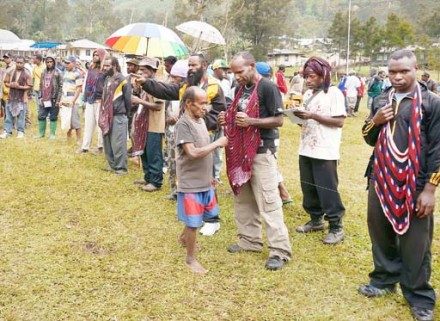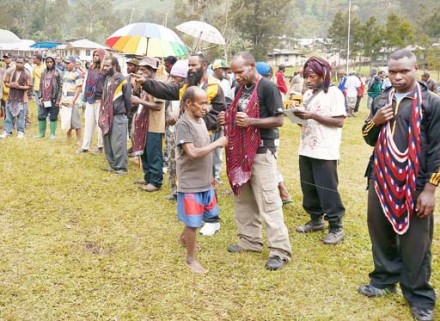In a posting immediately after polling day last week, Marcus Mietzner and I argued that having failed to win the election, it was now likely that Prabowo Subianto’s camp would try to steal the result. We found it hard to discern any other reason for producing and publicising fake quick counts that purported to show that Prabowo was the winner.
Now that the formal count is well underway, reports have emerged that Prabowo’s super-wealthy brother, Hashim Djojohadikusumo made a visit to Papua and West Papua provinces a few days after the poll. Sydney Morning Herald journalist, Michael Bachelard reported on twitter that Hashim said he went there for “Monitoring Results” and that he visited 19 places in the provinces (though this, he said, included places he visited before the election). His visit also raised questions in the Indonesian media, specifically the daily Suara Pembaruan.
We have no direct evidence that Hashim was doing anything untoward in Papua. Even so, the visit is suspicious and has excited much social media commentary among Jokowi supporters. If Hashim, the second most important person in Prabowo’s campaign, was most interested in checking results why wouldn’t he go to provinces with large numbers of voters (e.g. West Java with 33 million voters or East Java with 31 million) rather than Papua and West Papua with 3.2 million and 715 thousand respectively? Why wouldn’t he go to places where the Prabowo campaign had done particularly well, such as West Sumatra, or West Nusa Tenggara province?
One possible explanation is that Papua and West Papua provinces are the places where it would be easiest to buy the count. It’s not only that the governors of both provinces – Lukas Enembe in Papua and Abraham Atururi in West Papua – are Prabowo supporters (and Hashim was reported meeting with Atururi on his recent visit, and may have met with Enembe as well).
More importantly, electoral administration is notoriously poor – and electoral fraud notoriously rampant – in this part of Indonesia. One reason is simply the poor infrastructure, especially in upland parts of Papua province that makes distributing the ballots and collecting them particularly fraught.
This remoteness, and poor governance generally, also breeds manipulation, such as inflation of voter lists and turnout. In the April 2014 election, Cillian Nolan of the Institute for Policy of Analysis of Conflict found voter turnout as being recorded at over 99% in more than half of Papua’s districts – a fantastical figure given that voter turnout was about 75% nationwide.The inflation of voter lists has also been identified by Nolan as a significant problem, and there is every reason to believe it persists in this election. The figure of 3.2 million voters in the list held by the KPU (General Election Commission) is higher than the 2010 census result of 2.7 million for Papua’s entire population. In most provinces, the voter roll is about two-thirds of the 2010 population.
Finally, and most significantly, the so-called ‘noken system’ of communal voting in which votes are not secret or where community leaders vote on behalf of their entire communities makes the vote particularly open to manipulation. Upheld by Indonesia’s Constitutional Court, Nolan writes that “noken voting is best understood as meaning bloc voting and an avenue towards fraud”. It often produces results in which entire communities vote en bloc for a single candidate and, when combined with manipulation of the electoral roll and the count, can produce hugely inflated results in support of a particular candidate in a local or parliamentary election.
In other parts of Indonesia, and abroad, the Jokowi camp has been able to detect many cases of apparent fraud or manipulation in the count. For example, in Malaysia, postal votes were heavily weighted in favour of Prabowo, way out of proportion with the ballots that were cast at polling booths in the country. In parts of Madura (which we identified as one danger area in our earlier article) Jokowi recorded no votes at all.
In most places, however, the presence of witnesses for the Jokowi campaign at polling booths, a parallel count being carried out by Jokowi’s supporters, and a remarkable crowdsourced monitoring effort initiated by citizens, is allowing instances of manipulation to be identified. Many individual examples have been identified in which C1 forms – the forms that record a polling booth result – have been manipulated to inflate the count for Prabowo. Overall, however, these instances of fraud appear – so far – to be isolated and will probably not have a significant impact on the overall result, given the likely margin of Jokowi’s victory.
One of the problems with Papua is that it is already proving to be very slow in collating the results. At the time of writing, 98% of C1 forms have been uploaded on the General Election Commission website, with many provinces already having achieved 100% upload rates. In Papua province the figure is 19.85%, and in West Papua it is 59.47%. In many uplands districts where noken voting is practised no forms have been uploaded at all. This is in itself perhaps not surprising, given the difficulties of transportation, communication and administration in some of these places. In a few districts where the forms have been uploaded, remarkable results in favour of Prabowo have been recorded: in one village in Lanny Jaya, for instance, four polling booths had 500 votes for Prabowo, one had 400, and none had a single vote for Jokowi.
To be fair, however, in some other polling booths I’ve looked at on the KPU website, the noken system has advantaged Jokowi. The first reports of district results coming in from Papua so far all show handsome victories for Jokowi. So this could all come to nothing.
Even so, it’s worth asking: could widespread manipulation in Papua and West Papua make a difference to the national result? In the quick count carried out by Saiful Mujani Research and Consulting (the group with the largest sample of polling booths in its quick count) Jokowi won with about 70% of the vote in both provinces.
Potentially that’s about 2.8 million votes if we use the KPU’s obviously inflated voter list as our base. In our earlier piece, Marcus Mietzner and I estimated that Prabowo’s camp would need to shift about 3 million votes to win the election. Shifting the entire Papua vote would of course be an impossibility. Even so, a concerted attempt at fraud in this part of Indonesia could make a significant contribution toward the overall sum. According to Suara Pembaruan , Prabowo’s Merah-Putih Coalition claims 60% of the vote in Papua. Even shifting this amount would likely be easily detectable.
All reports suggest that the Jokowi camp is increasingly confident that the vote count is going well and that the final result will be in line with the estimates produced by the professional quick counts.
Nevertheless, Papua and West Papua are definitely provinces to keep an eye on as the results roll in over coming days. Perhaps Hashim’s trip really was just an innocent visit to check on supporters. But there is one Southeast Asian precedent to keep in mind: in 2004, Gloria Arroyo won the Philippine presidential contest by way of extensive fraud, most of it conducted in the Mindanao region, another poorly governed and conflict-afflicted region on the nation’s periphery.
The fact that we can even speculate that Papua might play a role like that in Indonesia is one more reminder that problems of conflict and poor governance in this region are long overdue for serious attention from Jakarta.
……………
Edward Aspinall is Professor at the Department of Political and Social Change at the Australian National University’s College of Asia & the Pacific.
 Facebook
Facebook  Twitter
Twitter  Soundcloud
Soundcloud  Youtube
Youtube  Rss
Rss 
